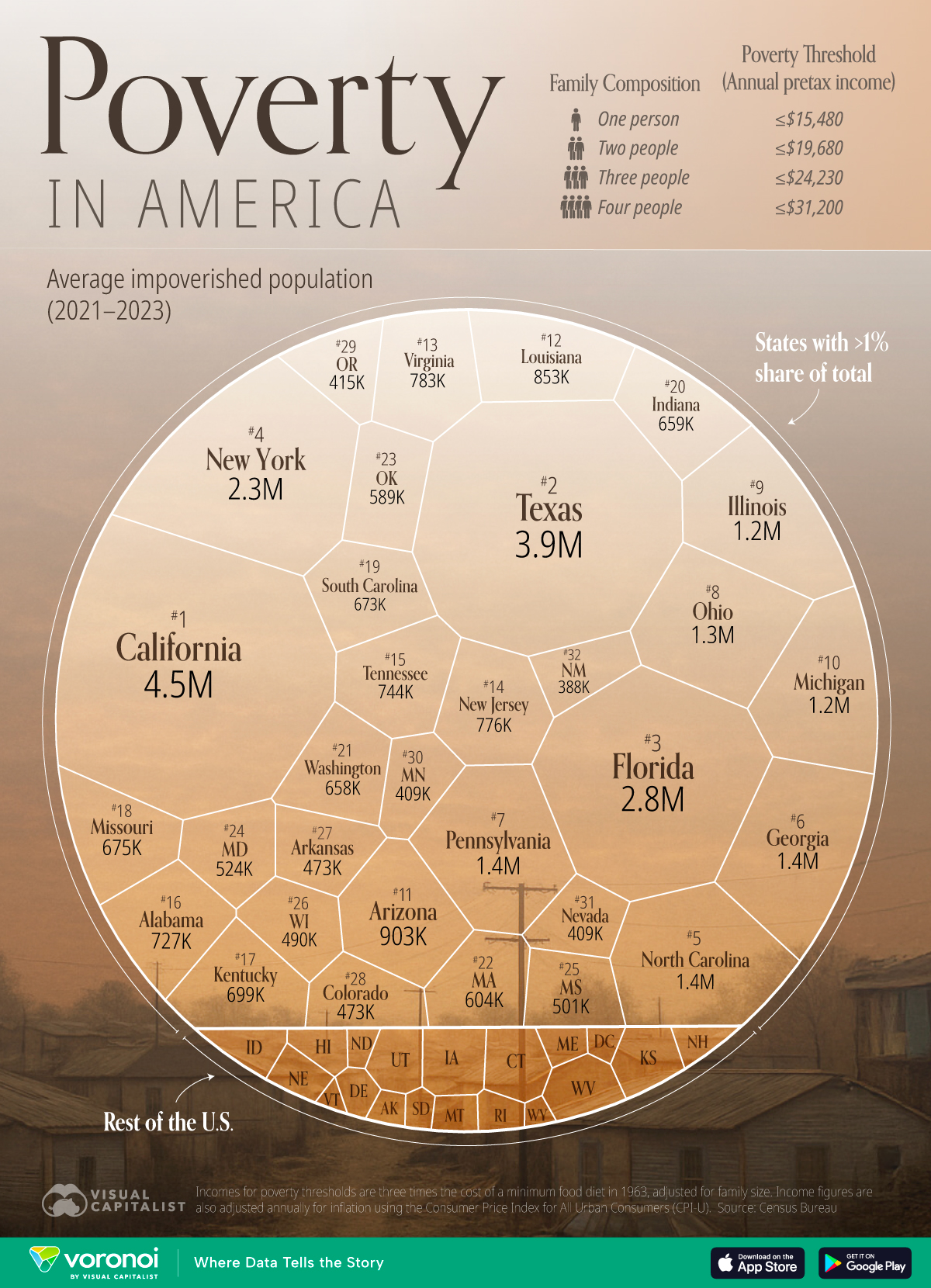Where Are the Poor in America? States Ranked by Poverty
This was originally posted on our Voronoi app. Download the app for free on iOS or Android and discover incredible data-driven charts from a variety of trusted sources.
Key Takeaways
- Naturally, the largest states (California, Texas, Florida, New York) will have the most number of Americans who are struggling.
- But Americans in some states are clearly struggling more.
- For example, North Carolina is 9th by overall population but 5th by Americans in poverty (1.4 million). Its poverty rate is 13.2%.
America loves to tally its billionaires and track the S&P’s every tick, but the millions struggling to cover rent or stock the fridge rarely make the headline scroll.
Poverty is the country’s most persistent invisibility cloak, present in every zip code, yet ignored in a culture that equates success with worth.
In this chart we break down where the poor in America actually live, ranked by each state.
Data for this visualization is sourced from the U.S. Census Bureau.
It averages three years of Current Population Survey results (2021-2023) to estimate how many residents in each state live below the federal poverty line.
Read the last section for more information on their methodology.
Ranked: U.S. States by Residents in Poverty
Four populous states—California, Texas, Florida, and New York—account for 13.5 million low-income residents, or more than one-third of all Americans in poverty.
California alone has 4.5 million people struggling to make ends meet, roughly the population of metropolitan Phoenix.
| Rank | State | # in Poverty (Thousands, Sortable) |
# in Poverty (Readable) |
Share of All Americans in Poverty |
|---|---|---|---|---|
| 1 | California | 4,521 | 4.5M | 12.0 |
| 2 | Texas | 3,910 | 3.9M | 10.4 |
| 3 | Florida | 2,782 | 2.8M | 7.4 |
| 4 | New York | 2,349 | 2.3M | 6.2 |
| 5 | North Carolina | 1,416 | 1.4M | 3.8 |
| 6 | Georgia | 1,400 | 1.4M | 3.7 |
| 7 | Pennsylvania | 1,351 | 1.4M | 3.6 |
| 8 | Ohio | 1,272 | 1.3M | 3.4 |
| 9 | Illinois | 1,245 | 1.2M | 3.3 |
| 10 | Michigan | 1,186 | 1.2M | 3.2 |
| 11 | Arizona | 903 | 903K | 2.4 |
| 12 | Louisiana | 853 | 853K | 2.3 |
| 13 | Virginia | 783 | 783K | 2.1 |
| 14 | New Jersey | 776 | 776K | 2.1 |
| 15 | Tennessee | 744 | 744K | 2.0 |
| 16 | Alabama | 727 | 727K | 1.9 |
| 17 | Kentucky | 699 | 699K | 1.9 |
| 18 | Missouri | 675 | 675K | 1.8 |
| 19 | South Carolina | 673 | 673K | 1.8 |
| 20 | Indiana | 659 | 659K | 1.8 |
| 21 | Washington | 658 | 658K | 1.7 |
| 22 | Massachusetts | 604 | 604K | 1.6 |
| 23 | Oklahoma | 589 | 589K | 1.6 |
| 24 | Maryland | 524 | 524K | 1.4 |
| 25 | Mississippi | 501 | 501K | 1.3 |
| 26 | Wisconsin | 490 | 490K | 1.3 |
| 27 | Arkansas | 473 | 473K | 1.3 |
| 28 | Colorado | 473 | 473K | 1.3 |
| 29 | Oregon | 415 | 415K | 1.1 |
| 30 | Minnesota | 409 | 409K | 1.1 |
| 31 | Nevada | 409 | 409K | 1.1 |
| 32 | New Mexico | 388 | 388K | 1.0 |
| 33 | Connecticut | 318 | 318K | 0.8 |
| 34 | Iowa | 287 | 287K | 0.8 |
| 35 | West Virginia | 268 | 268K | 0.7 |
| 36 | Kansas | 255 | 255K | 0.7 |
| 37 | Utah | 226 | 226K | 0.6 |
| 38 | Idaho | 172 | 172K | 0.5 |
| 39 | Nebraska | 165 | 165K | 0.4 |
| 40 | Hawaii | 133 | 133K | 0.4 |
| 41 | Maine | 120 | 120K | 0.3 |
| 42 | Montana | 109 | 109K | 0.3 |
| 43 | Delaware | 98 | 98K | 0.3 |
| 44 | New Hampshire | 98 | 98K | 0.3 |
| 45 | Rhode Island | 96 | 96K | 0.3 |
| 46 | District of Columbia | 88 | 88K | 0.2 |
| 47 | Alaska | 74 | 74K | 0.2 |
| 48 | South Dakota | 74 | 74K | 0.2 |
| 49 | North Dakota | 72 | 72K | 0.2 |
| 50 | Vermont | 49 | 49K | 0.1 |
| 51 | Wyoming | 49 | 49K | 0.1 |
| N/A |  U.S. U.S. |
37,610 | 37.6M | N/A |
While the Golden State’s higher cost of living may impact this figure, it also underscores how expensive housing can compound economic hardship, even in high-income states.
Poverty Rates vs. Absolute Numbers
A fair criticism of this visualization is that it doesn’t account for population.
We previously mapped out poverty rates by state in the country to help cover this angle. The table below has the relevant figures.
| Rank | State | State Code | Share of Population in Poverty |
# in Poverty |
|---|---|---|---|---|
| 1 | Louisiana | LA | 18.9% | 853K |
| 2 | New Mexico | NM | 18.5% | 388K |
| 3 | Mississippi | MS | 17.3% | 501K |
| 4 | Arkansas | AR | 15.8% | 473K |
| 5 | Kentucky | KY | 15.7% | 699K |
| 6 | West Virginia | WV | 15.3% | 268K |
| 7 | Oklahoma | OK | 14.9% | 589K |
| 8 | Alabama | AL | 14.6% | 727K |
| 9 | District of Columbia | DC | 13.4% | 88K |
| 10 | North Carolina | NC | 13.2% | 1.4M |
| 11 | Texas | TX | 13.1% | 3.9M |
| 12 | Georgia | GA | 12.9% | 1.4M |
| 13 | Nevada | NV | 12.9% | 409K |
| 14 | South Carolina | SC | 12.7% | 673K |
| 15 | Florida | FL | 12.5% | 2.8M |
| 16 | Arizona | AZ | 12.4% | 903K |
| 17 | New York | NY | 12.1% | 2.3M |
| 18 | Michigan | MI | 11.9% | 1.2M |
| 19 | California | CA | 11.7% | 4.5M |
| 20 | Missouri | MO | 11.1% | 675K |
| 21 | Ohio | OH | 10.9% | 1.3M |
| 22 | Pennsylvania | PA | 10.7% | 1.4M |
| 23 | Tennessee | TN | 10.6% | 744K |
| 24 | Alaska | AK | 10.4% | 74K |
| 25 | Illinois | IL | 10% | 1.2M |
| 26 | Oregon | OR | 9.8% | 415K |
| 27 | Indiana | IN | 9.7% | 659K |
| 28 | Montana | MT | 9.7% | 109K |
| 29 | Delaware | DE | 9.6% | 98K |
| 30 | Hawaii | HI | 9.3% | 133K |
| 31 | North Dakota | ND | 9.3% | 72K |
| 32 | Virginia | VA | 9.2% | 783K |
| 33 | Iowa | IA | 9% | 287K |
| 34 | Idaho | ID | 8.9% | 172K |
| 35 | Kansas | KS | 8.9% | 255K |
| 36 | Rhode Island | RI | 8.9% | 96K |
| 37 | Connecticut | CT | 8.8% | 318K |
| 38 | Massachusetts | MA | 8.8% | 604K |
| 39 | Maine | ME | 8.7% | 120K |
| 40 | Wyoming | WY | 8.6% | 49K |
| 41 | Maryland | MD | 8.5% | 524K |
| 42 | Washington | WA | 8.5% | 658K |
| 43 | Nebraska | NE | 8.4% | 165K |
| 44 | New Jersey | NJ | 8.4% | 776K |
| 45 | Wisconsin | WI | 8.4% | 490K |
| 46 | South Dakota | SD | 8.3% | 74K |
| 47 | Colorado | CO | 8.2% | 473K |
| 48 | Vermont | VT | 7.7% | 49K |
| 49 | Minnesota | MN | 7.2% | 409K |
| 50 | New Hampshire | NH | 7.1% | 98K |
| 51 | Utah | UT | 6.7% | 226K |
| N/A | U.S. | US | 11.4% | 37.6M |
In fact, California’s poverty rate is 12%, solidly middle of the pack.
But its 4.6 million poor residents are larger than the entire state of Oklahoma.
By contrast, Mississippi’s headline-grabbing 17% rate represents about 500,000 people.
Thus, a national food-assistance program needs almost nine times the meal budget for California, even though Mississippi is poorer than California.
Even within similar rate bands, scale varies wildly: Louisiana (18.9%) has 853,000 million people in poverty, compared with 388,000 in New Mexico (18.5%).
Thus, absolute numbers are also necessary to flag where to park mobile clinics, expand SNAP distribution sites, and hire caseworkers.
How Poverty is Measured in America
The way the Census Bureau calculates this line is important and can impact the data.
They use pretax household income against a threshold at three times the cost of a minimum food diet from 1963, adjusted for family size and inflation.
For reference, this is a quick guide on how much a household needs to be earning to be considered below the poverty line in 2023.
- One person: ≤$15,480
- Two people: ≤$19,680
- Three people: ≤$24,230
- Four people: ≤$31,200
Learn More on the Voronoi App 
If you enjoyed today’s post, check out What is Costs to Buy a Home in America on Voronoi, the new app from Visual Capitalist.

